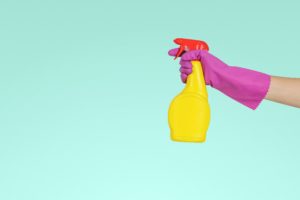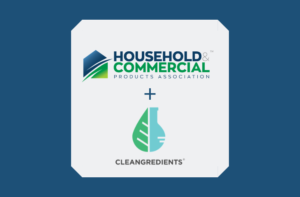Cleaning workers have a difficult and often stressful job. Many are under pressure to clean more space in less time and with fewer workers. Shift work and isolation can also contribute to job-related stress and exhaustion. Partly as a result of this pressure, cleaning workers tend to suffer more workplace injuries than other groups of workers.
Ergonomic hazards are part of the problem. Lifting heavy objects like trash cans and repetitive motions like vacuuming can lead to injury, especially when workers are under pressure to work quickly. But the chemicals in cleaning products used by janitorial workers can also pose a serious hazard. Research on workplace injuries backs this up: in additional to musculoskeletal problems, respiratory and skin diseases are among the most common work-related health problems suffered by cleaners. These include asthma, eczema, and dermatitis. For example, California’s Work-Related Asthma Prevention Program found that nearly 10% of work-related asthma cases were caused by exposure to cleaning products. This issue affects not only janitorial workers, but also others working in an environment where cleaning products are used.
So what can workplaces do to prevent these issues? OSHA’s hierarchy of controls to mitigate safety hazards identifies elimination of the hazard or substitution with a less hazardous alternative as the best way to deal with a health or safety hazard. Only if elimination or substitution are not viable options should the workplace turn to engineering controls, administrative controls, or personal protective equipment to protect workers from workplace hazards.

In the case of janitorial workers using cleaning products, the hierarchy of controls suggests that elimination of unnecessary products and substitution of safer products is the most effective way to protect workers from chemical hazards.
However, it’s important to consider the workplace environment as a whole, rather than making changes to product selection in a vacuum. Workers not only want safe products – they also want effective products that will enable them to do their jobs efficiently. Products that don’t work well can actually place additional pressure on janitors as they struggle to complete their jobs during the allotted time, leading to frustration and potentially increasing the risk of injury. Fortunately, thanks to improvements in formulation, many products on the market today are both safer for workers and perform effectively.
Third party certification programs can help identify institutional cleaning products that meet this high bar. For example, EPA’s Safer Choice program has certified over 2,000 safer products in a wide range of categories for both home and institutional use. All ingredients in these products must meet the program’s criteria for a number of human and environmental health endpoints. In addition, all certified products must meet performance standards. Using a reputable third party certification like Safer Choice to select safer products helps protect against false environmental and health claims, as well as products that might use safer ingredients but just won’t work effectively.
Communication and transparency is important to ensure that workers know how to handle products safely. While OSHA requires disclosure of chemical hazards to workers via Safety Data Sheets, these don’t typically list all ingredients in the product. In some cases, information may need to be provided in a language other than English to ensure worker understanding. New ingredient disclosure requirements for cleaning products coming into effect will give workers more information about what’s in the products they use. Training is also important to ensure that workers know how to use the products safely and effectively – for example, not mixing products that could result in a hazardous reaction, and using protective equipment such as gloves or eye protection where appropriate. A comprehensive training program can also help protect janitorial workers from other workplace hazards, including ergonomic hazards.
Engagement between employers and workers can also help to ensure that janitors understand the reasons for green initiatives, including the use of green cleaning products, and have the support they need to implement them safely and effectively. While safer cleaning products are an important way to reduce chemical hazards to cleaning workers, they should be one part of a comprehensive program that ensures safe and healthy working conditions while treating workers with respect.












